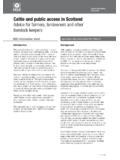Transcription of Effects of slaughter method on carcass and meat ...
1 1 Effects of slaughter method on carcass and meat characteristics in the meat of cattle and sheep By Dr ANIL Funding organisation: EBLEX and AHDB Background It has become apparent that the market for meat from animals slaughtered by religious methods is a significant proportion of the UK production and supply. Although there has been research in this area, most information originates from work in conventional slaughter methods with limited comparison to religious slaughter . However, a few specific projects, for example Humane slaughter Association funded work, have addressed aspects of animal welfare as well as quality issues of religious slaughter (see list under relevant publications). The most recent project that has attempted to gather information on religious slaughter methods, practices, markets and consumers is the DIALREL project funded by the European Commission.
2 Its findings in relation to current situations in member countries, rules, markets, consumer concerns and demands as well as a set of recommendations for best practices has been collected (see ). In addition, gaps in information and areas that need addressing have been identified. In the UK, much discussion about religious slaughter is in progress. The following project has been carried out in order to inform and facilitate discussions on the merits of different slaughter practises and with particular reference to carcase and meat quality characteristics of cattle and sheep slaughtered by religious methods as required by EBLEX. Objectives of the work 1. Research and collate information relating to conventional and religious slaughter methods and write an overview of Halal slaughter with and without stunning, Shechita and conventional/non-religious slaughter methods.
3 2. Prepare and submit a literature search and review document to include the effect of slaughter method on slaughter parameters ( times to loss of consciousness, bleed out rates and duration, amount of blood retained, methods to determine effective slaughtering including indicators of unconsciousness, signs of recovery, sets of recommendations and guidelines) 2 3. Review research on the effect of slaughter methods on carcass and meat quality, including objective assessment criteria ( pH, colour), eating quality and effective microbiology, food hygiene implications. 4. Prepare a report on current national practices, religious slaughter rules, identify gaps in knowledge and suggest areas that need addressing. Deliverables A written interim report within 2 months of starting date, followed by a final report to be submitted by 30 October 2011 provided the project starts on 1 July 2011.
4 3 Table of Contents: 1 Overview of current slaughter ..4 Electrical Captive bolt (Mechanical) Other stunning and slaughter Effects of stunning and slaughter on carcass and meat 2. Religious slaughter Rules of Halal Current Halal slaughter Shechita-Jewish Rules of Current Shechita Other religious slaughter 3 Preslaughter Restraint during conventional Restraint of cattle for slaughter without Restraint of small ruminant for slaughter without Restraining for post neck cut 4 Effects and consequences of slaughter methods (Principles and concerns)..48 Physiological Stress, pain and Consciousness and unconsciousness ..51 Assessment of consciousness / unconsciousness ..51 Measurement and interpretation of brain electrical Exsanguination or bleed out ..53 Loss of blood and blood Cerebral perfusion after neck cutting.
5 54 Time to loss of consciousness after exsanguination ..55 Clinical signs during the post-cut period ..55 Post neck cut stunning ..56 5 Effects of religious slaughter on carcass and meat Blood loss and 6 National and international legal UK and European 7 Codes of practices and 8 Conclusions and outstanding 9 4 Stunning and slaughter methods 1 Overview of current slaughter practices Animal production and stunning and slaughter procedures that produce meat for the consumer need to maintain product quality as well as protecting animal welfare. slaughter methods, if not optimally employed, can adversely affect quality, operator and food safety and as a result cause downgrading of carcass and meat. Undesirable defects include haemorrhages, bruising, broken bones, pale soft exudative (PSE) and dark firm dry (DFD) meat, short shelf life and even condemnation of meat.
6 Inefficient or incorrect stunning and slaughter could not only compromise animal welfare but endanger operators and public health. slaughter procedures are usually regulated by legislation, codes of practice and recommendations for different species also exist. The suitability of commonly used methods depends on species, availability of facilities, consumer demands and economic considerations. This review deals with aspects of conventional methods as well as religious slaughter methods and their acceptability in terms of legislation, Effects on welfare and quality. Following sources were extensively used and have more in depth information: DIALREL. Reports and factsheet. Anil, Haluk and Lambooij, Bert 2009. Stunning and slaughter methods. In: Welfare of production animals: Assessment and management of risks, Volume 5, Food safety Assurance and veterinary Public Health, Eds: Smulders, FJM and Algers, Bo.
7 Wageningen Publs. Levinger, , 1995. Shechita in the Light of the Year 2000. Maskil, L. David (Publ). Al-Hafiz, Masri. 1989. Animals in Islam. The Athene Trust. ISBN 1-870603-01-X Rosen, , 2004. Physiological insights into Shechita. The Veterinary Record 154, 759-765. slaughter methods can be classified as conventional and religious applications. methods Effective stunning is aimed at ensuring that animals do not feel pain and distress as well as facilitating carcass control and effective bleed out either in unconscious animal or killing by cardiac arrest. According to the EU Council Directive (European Community, 1993) and the impending European COUNCIL REGULATION ((EC) No 1099/2009) ( European Community,2009) on the protection of animals at the time of slaughter it is stated that animals brought into abattoirs for slaughter shall be either moved or lairaged, restrained and stunned to make them 5 unconscious before slaughter .
8 Permitted methods for stunning are 1) captive bolt pistol: mechanical methods, 2) electrical stunning and 3) gas stunning. Electrical stunning This is the most common stunning and slaughter application (Gregory and Wotton, 1985; Anil et al, 1997) It works by producing brain dysfunction and unconsciousness with or without subsequent killing by cardiac arrest so that bleed out (exsanguination) is carried out (Cook et al, 1996; Anil, 1991; Anil and McKinstry, 1991; Anil and McKinstry, 1992; Cook et al, 1999). Head-only electrical stunning Electrical currents, in sufficient quantities, applied on the head produce epilepsy ( grand mal or seizure-like state), spreading across parts of the brain stimulating other cells. This effect, characterised by rapid and extreme depolarisation of the membrane potential and development of a synchronised electrical response, can be measured and observed on the recorded electroencephalogram (EEG) as small waves with high amplitude in the tonic phase (rigid), and low frequency in the clonic phase (high motor activity in muscles) resulting in depression of electrical activity in pigs, sheep and cattle (Lambooij,1982a,b; Anil, 1991; Anil and McKinstry, 1992; Anil and McKinstry, 1998).
9 Human subjects are known to become unconscious during epilepsy, by analogy, the effect is also assumed to be similar in other mammals. It has been demonstrated that several neurotransmitters are released in the brain during such an insult. Several studies have suggested that the general epileptiform insult induced by electrical stunning is dependent on the release of vasopressin, oxytocin, glutamate, aspartate and GABA (gamma amino-4-butyric acid). The first effect, tonic phase, occurs through the release of glutamate, followed by the release of GABA that helps with recovery if the animal is not killed. A minimum current threshold level that is a function of electrical impedance in the head is required for producing such an effect. The most common electrical stunning method for animals uses a frequency of 50 Hz alternating current (AC.)
10 , similar to mains electricity, with sinusoidal waveform. The frequency can be high Hz (Anil and McKinstry, 1992; Lambooij et al, 1997) and the waveform can be square or rectangular. High frequency electrical stunning can induce epilepsy in the brain. However, the durations are shorter than those with 50 Hz and high frequencies do not fibrillate the heart. Head-to-back (cardiac arrest) electrical stunning This method involves induction of an epileptic state in the brain with concomitant cardiac arrest by electrical currents applied in the chest. The idea behind this method is that animal welfare is maintained because any possible recovery is prevented as stopping the heart kills the animal (Anil and McKinstry, 1991; Wotton et al, 1992; Gregory, 1994). Additionally, convulsions caused by epilepsy are greatly reduced making carcasses more manageable hence improving operator safety.






